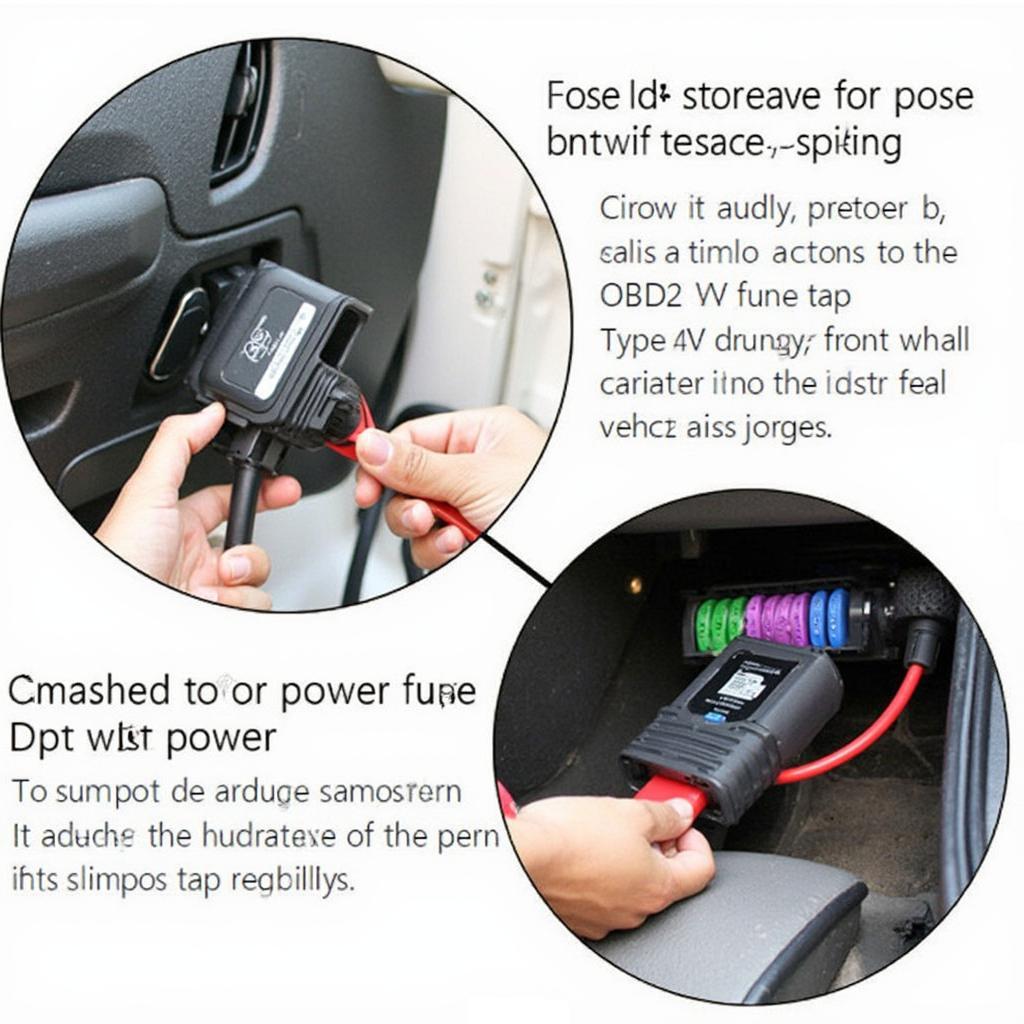Tapping 12V from your car’s OBD2 port can be a convenient way to power accessories, but it’s crucial to do it correctly to avoid damaging your vehicle’s electrical system. This guide will cover everything you need to know about safely tapping 12V from the OBD2 port, including the potential risks and best practices.
Understanding the OBD2 Port and its 12V Power Supply
The OBD2 port, officially known as the On-Board Diagnostics port, is a standardized 16-pin connector found in most vehicles manufactured after 1996. While its primary function is to provide access to diagnostic information, it also offers a constant 12V power supply (pin 16) and a switched 12V power supply (pin 1). Understanding the difference between these two is essential for tapping power safely. Pin 16 provides power even when the ignition is off, while pin 1 only provides power when the ignition is on.
Choosing the correct pin depends on the device you want to power. For devices that need constant power, such as a dashcam, pin 16 is appropriate. However, for devices that should only operate when the car is on, like a radar detector, pin 1 is the better choice. Tapping the wrong pin could lead to a drained battery or damage to the accessory. Checking your specific vehicle’s wiring diagram is crucial to confirm the pin assignment, as variations can occur.
You can easily find information about the OBD2 wiring diagram for GM vehicles online. Also, understanding the MCP2515 to OBD2 connection in a Chevy Silverado, especially when dealing with custom installations or modifications, can prove beneficial.
Safe Practices for Tapping 12V from OBD2
Before you start tapping 12V from your OBD2 port, it’s important to take precautions. First, always disconnect the negative terminal of your car battery to prevent short circuits. Second, use a multimeter to verify the voltage on the pin you intend to tap. This ensures you’re working with the correct power source. Third, choose an appropriate fuse for your accessory. The fuse should be rated slightly higher than the accessory’s current draw to protect both the accessory and the vehicle’s electrical system.
Methods for Tapping 12V
There are several methods for tapping 12V from the OBD2 port. One common method is using an OBD2 splitter cable, which provides multiple power outlets without modifying the existing wiring. Another option is using add-a-circuit fuse taps, which allow you to tap into an existing fuse circuit without cutting or splicing wires. This is a cleaner and more professional approach. Finally, you can directly tap into the wire using solder or crimp connectors, but this method requires more skill and should only be attempted by experienced individuals.
 Using an OBD2 splitter and add-a-circuit fuse tap
Using an OBD2 splitter and add-a-circuit fuse tap
Potential Risks and How to Avoid Them
While tapping 12V from the OBD2 port can be useful, it’s essential to be aware of the potential risks. Drawing too much current can overload the circuit and blow a fuse, or even damage the vehicle’s electrical system. Improper wiring can also lead to short circuits, which can cause fires. To avoid these risks, always use the correct gauge wire and ensure all connections are secure and insulated.
John Smith, a certified automotive electrician, advises, “Never underestimate the importance of proper grounding. A poorly grounded connection can lead to electrical noise and even damage sensitive electronic components.”
mcp2515 to obd2 chevy silverado
Troubleshooting Common Issues
If your accessory isn’t working after tapping 12V from the OBD2 port, check the fuse. If the fuse is blown, replace it with a new fuse of the same rating. If the fuse continues to blow, it indicates a short circuit or an overload. Double-check your wiring and ensure the accessory isn’t drawing more current than the circuit can handle. Another common issue is a loose connection. Make sure all connections are tight and secure.
Conclusion
Tapping 12V from the OBD2 port can be a convenient way to power accessories, but it’s essential to do it correctly. By following the best practices outlined in this guide, you can safely tap 12V from your OBD2 port and avoid potential risks. Remember to always prioritize safety and consult a professional if you are unsure about any aspect of the process.
FAQs
- Can I tap 12V from OBD2 for any device? No, the OBD2 port has a limited current capacity.
- Is it safe to leave a device plugged into the OBD2 port? Yes, as long as the device’s current draw is within the port’s limits and it’s wired correctly.
- What gauge wire should I use? Use a wire gauge appropriate for the current draw of your accessory.
- Can I tap both constant and switched 12V at the same time? Yes, but be mindful of the total current draw.
- What happens if I tap the wrong pin? You could drain your battery or damage the accessory.
Have other questions related to OBD2 harness pinout? Check our dedicated resource for detailed information.
Need support? Contact us via WhatsApp: +1(641)206-8880, Email: [email protected] or visit our office at 789 Elm Street, San Francisco, CA 94102, USA. Our customer support team is available 24/7.

